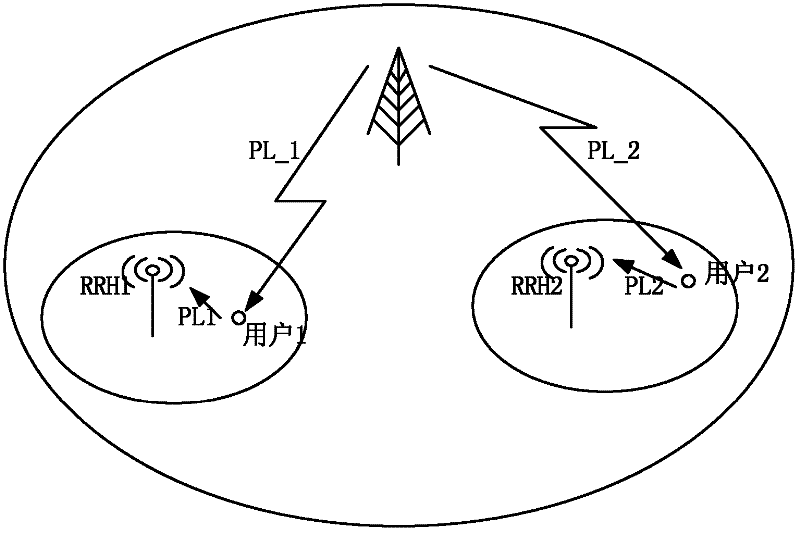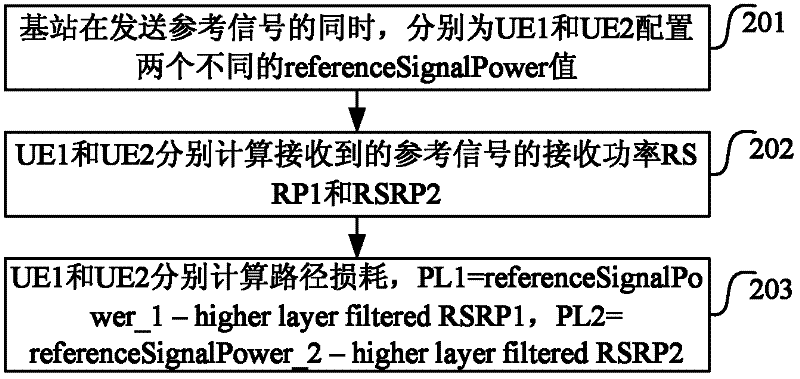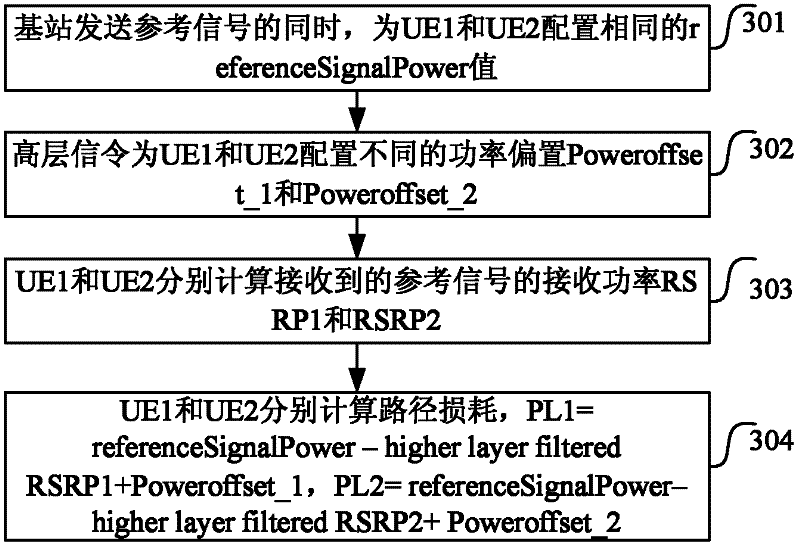Power control method of uplink signals, network side equipment and user equipment
A technology for network side equipment and user equipment, applied to the power control of uplink signals, network side equipment and user equipment fields, can solve problems affecting UE, inaccurate signal transmission power estimation, and uplink signal receiving user interference, etc., to reduce Effects of interference and accurate path loss
- Summary
- Abstract
- Description
- Claims
- Application Information
AI Technical Summary
Problems solved by technology
Method used
Image
Examples
Embodiment 1
[0082] This embodiment is a specific example for mode one;
[0083] Such as figure 1 As shown, there are two users in a serving cell, denoted as UE1 and UE2. Among them, the downlink path loss from UE1 to the serving cell base station is denoted as PL_1, and the downlink path loss from UE2 to the serving cell base station is denoted as PL_2. The RRHs (Remote Radio Heads) closest to the two UEs are denoted as RRH1 and RRH2, respectively. The path loss of the uplink from RRH1 to UE1 is denoted as PL1, and the path loss of the uplink from RRH2 to UE2 is denoted as PL2. In the scenario shown in the figure, the path losses PL_1 and PL_2 of the downlink are much larger than the actual path losses PL1 and PL2 of the uplink channel.
[0084] Such as figure 2 The power control method shown in this embodiment includes:
[0085] Step 201: While sending the reference signal, the base station configures two different referenceSignalPower values for UE1 and UE2 respectively, which are record...
Embodiment 2
[0089] This embodiment is a specific example for mode two;
[0090] Such as figure 1 As shown, there are two users in a serving cell, denoted as UE1 and UE2. Among them, the downlink path loss from UE1 to the serving cell base station is denoted as PL_1, and the downlink path loss from UE2 to the serving cell base station is denoted as PL_2. The RRHs closest to the two UEs are denoted as RRH1 and RRH2. The uplink path loss from RRH1 to UE1 is denoted as PL1, and the uplink path loss from RRH2 to UE2 is denoted as PL2. In the scenario shown in the figure, the path losses PL_1 and PL_2 of the downlink are much larger than the actual path losses PL1 and PL2 of the uplink channel.
[0091] Such as image 3 The power control method shown in this embodiment includes:
[0092] Step 301: When the base station sends the reference signal, it configures the same referenceSignalPower value for UE1 and UE2, which is recorded as referenceSignalPower;
[0093] Step 302: High-level signaling confi...
Embodiment 3
[0097] This embodiment is a specific example for mode three;
[0098] Such as figure 1 As shown, there are two users in a serving cell, denoted as UE1 and UE2. Among them, the downlink path loss from UE1 to the serving cell base station is denoted as PL_1, and the downlink path loss from UE2 to the serving cell base station is denoted as PL_2. The RRHs closest to the two UEs are denoted as RRH1 and RRH2. The uplink path loss from RRH1 to UE1 is denoted as PL1, and the uplink path loss from RRH2 to UE2 is denoted as PL2. In the scenario shown in the figure, the path losses PL_1 and PL_2 of the downlink are much larger than the actual path losses PL1 and PL2 of the uplink channel.
[0099] Such as Figure 4 The power control method shown in this embodiment includes:
[0100] Step 401: When the base station sends the reference signal, it configures the same referenceSignalPower value for UE1 and UE2, which is recorded as referenceSignalPower;
[0101] Step 402: high-layer signaling co...
PUM
 Login to View More
Login to View More Abstract
Description
Claims
Application Information
 Login to View More
Login to View More - R&D
- Intellectual Property
- Life Sciences
- Materials
- Tech Scout
- Unparalleled Data Quality
- Higher Quality Content
- 60% Fewer Hallucinations
Browse by: Latest US Patents, China's latest patents, Technical Efficacy Thesaurus, Application Domain, Technology Topic, Popular Technical Reports.
© 2025 PatSnap. All rights reserved.Legal|Privacy policy|Modern Slavery Act Transparency Statement|Sitemap|About US| Contact US: help@patsnap.com



